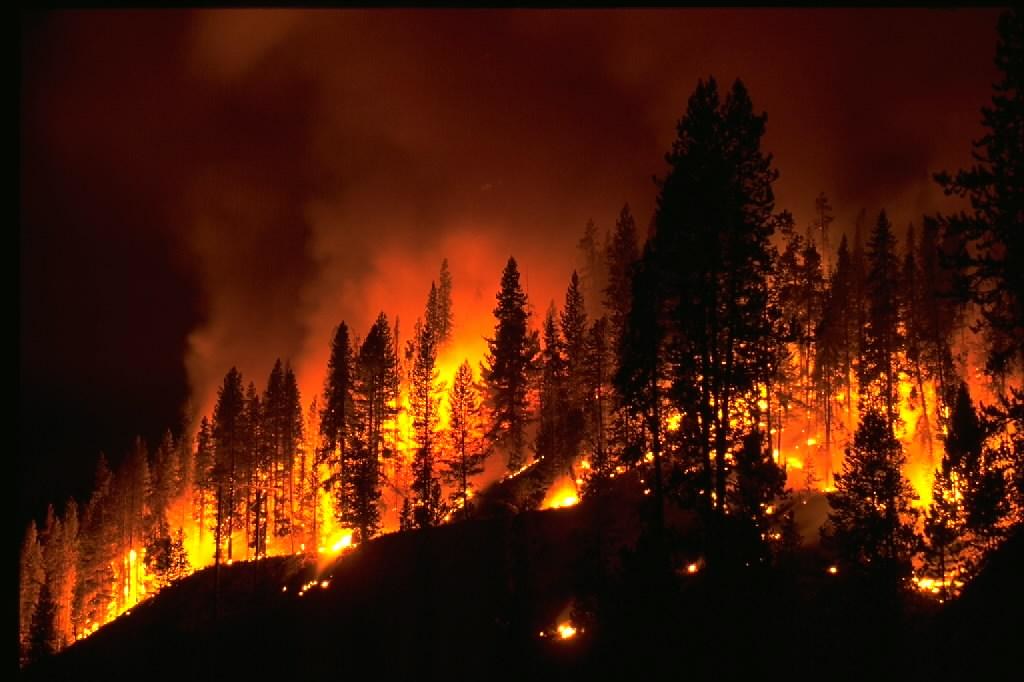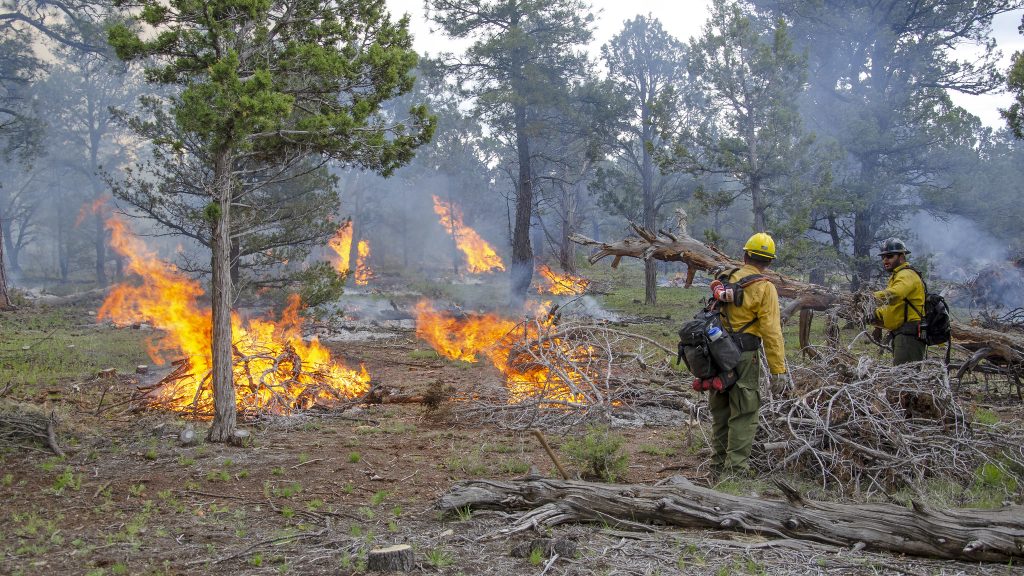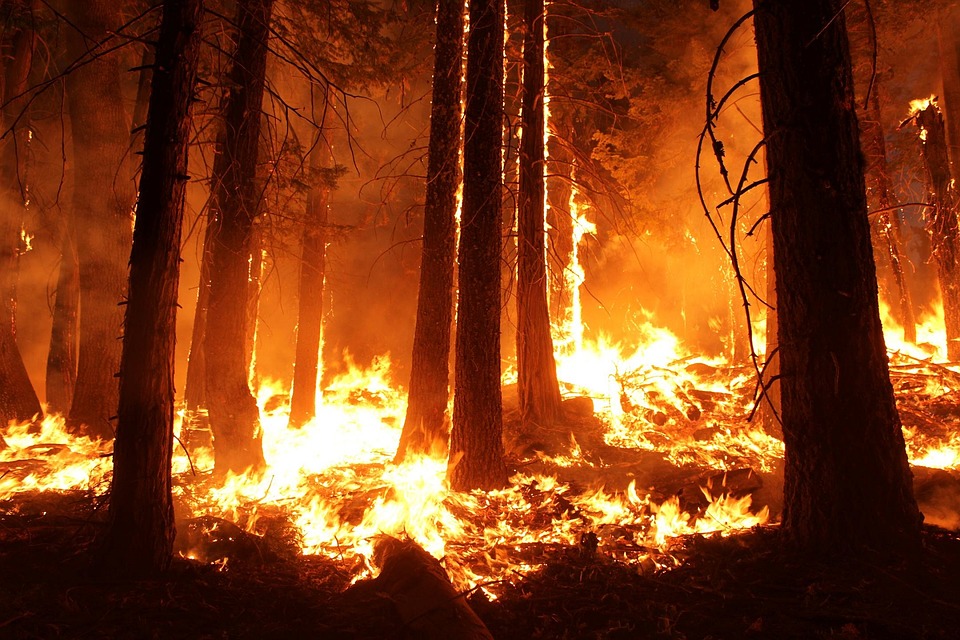By Jonathan Wood
Property and Environment Research Center PERC
Fix America’s Forests
A daunting restoration backlog in national Forests fuels the wildfire crisis. With increased funding coming, significant policy and litigation obstacles still stand in the way of forest restoration.

This article was originally published in Environmental Law Forum, a publication of the Environmental Law Institute.
As the Caldor Fire made its menacing march toward South Lake Tahoe last summer, it burned through more than two hundred thousand acres and destroyed more than seven hundred homes. While the effects of the fire were tragic, a greater disaster was fortunately averted when firefighters steered the fire away from the city and to an area where fuel loads had been reduced through active forest management. This tamed the fire enough to get it under control.
South Lake Tahoe was not the only area where recent management actions helped stave off disaster in 2021. The Dixie Fire, the largest single fire in California’s history, burned nearly one million acres, including 70 percent of Lassen Volcanic National Park. Thankfully, firefighters “successfully leveraged the park’s previous and current fire and fuels management projects to preserve park resources and structures,” according to a Park Service release. Without the benefit of these projects, more of the park’s infrastructure could have been lost, making its recovery from the fire more difficult.
Fire is nothing new to western forests, which are adapted to flame due to climate, terrain, and Indigenous tribes’ use of prescribed fire for millennia. However, recent catastrophic wildfires are far more destructive than historic fire regimes. They are more likely to threaten old-growth trees, wipe out habitat for wildlife, and cause erosion that degrades watersheds and fish habitat.
And due to growing populations near forests, modern fires also threaten communities and property in ways not seen before. From 2005 to 2020, wildfires destroyed nearly 100,000 structures. But 62 percent of this destruction occurred in 2017, 2018, and 2020 alone, according to a report from Headwater Economics.
As with any complex phenomenon, no single cause explains the wildfire crisis. Climate change plays a major role by extending the wildfire season and drying out fuel. But decades of mismanagement also bear a significant part of the blame. The federal government’s fire suppression efforts throughout much of the 20th century removed low-intensity fire from forests. Unrestrained by burning, brush and small-diameter trees grew to compete with old growth, making forests more vulnerable to insects and disease. Eventually, the buildup of excess fuel encouraged fires to burn hotter and to move from the ground to the canopy, where they do more damage and are more difficult to suppress.
Unlike other factors contributing to the wildfire crisis, excess fuels are a problem the Forest Service can do something about in the short term. But it isn’t—or at least not enough.
Forest restoration, the use of mechanical thinning, prescribed fire, replanting, and erosion control techniques, could reduce wildfire damage while promoting healthier forests. However, the Forest Service reports an 80-million-acre backlog in needed restoration, more than 40 percent of the 193 million acres under the agency’s control. 63 million of these acres are deemed by the agency to be at high or very high risk of burning. Add to this the 54 million acres managed by the Department of the Interior, and the total area of federal land facing high or very high fire risks is larger than the state of California.

Yet, from 2009 to 2018, the Forest Service averaged only 4 million acres of forest restoration per year. At that rate, it would take decades to address the backlog even if, miraculously, no new risks arose in the interim.
Of course, wildfires are not limited to federal forests. But they nonetheless play an outsized role, due to the concentration of federal land in the west as well as the conditions throughout many national forests. While the federal government owns less than a third of forests nationwide, it controls roughly half the forested land in Arizona and Washington, 60 percent in California, Colorado, Montana, and Oregon, and 80 percent in Idaho and Nevada. Due to this concentration and differences in how federal and private lands are managed, the total area of federal land facing high or very high wildfire risks far exceeds the 52 million private acres facing such risks. And federal lands are consistently overrepresented in the total area burned, including 75 percent of the acreage burned in the West during 2020.
Recognizing the clear shortfall in managing federal forests, Congress appropriated roughly $1.5 billion in the recent infrastructure legislation for mechanical thinning, prescribed fire, and post-fire recovery projects. But there may be a long road from appropriating money to on-the-ground restoration because the problem is not simply a lack of funds. In a recent report, “Fix America’s Forests: Reforms to Restore National Forests and Tackle the Wildfire Crisis,” the Property and Environment Research Center documents significant obstacles keeping the Forest Service from clearing the restoration backlog.
For one, the agency’s personnel have shifted dramatically away from forest management. Perhaps understandably, the Forest Service has responded to fire’s political salience by shifting resources to suppression. The programs that fell victim to the agency’s “fire borrowing,” a euphemism for raiding other programs to fund firefighting efforts, were “often those that improve the health and resilience of our forested landscapes and mitigate the potential for wildland fire in future years,” according to a 2015 Forest Service report. Consequently, the number of staff specializing in forest management has declined by half since 1992, while the firefighting staff has doubled. “It is readily apparent that the Forest Service cannot meet national direction to increase the pace and scale of forest restoration with its current workforce,” concludes a 2019 survey of Forest Service managers.
Second, forest restoration projects must navigate significant bureaucratic obstacles, including review under the National Environmental Policy Act. Depending on the extent of anticipated impacts, NEPA may require the Forest Service to analyze a project through, in order of increasing complexity and expense, a categorical exclusion, environmental assessment, or environmental impact statement. The agency may also need to develop a range of alternatives to the project and analyze their impacts. The resulting documents routinely span hundreds of pages of dense text, with appendixes spanning another thousand pages or more.
While well-intentioned, NEPA reviews can significantly increase project costs and inject substantial delays. The average delay varies by type of review, from nine months to document a project’s consistency with a categorical exclusion to nearly three years for an environmental impact statement.
Unfortunately, NEPA presents a bigger obstacle for forest restoration projects than other Forest Service projects. Forest restoration projects are roughly twice as likely to require an environmental impact statement than the agency’s overall average. Forest restoration project reviews also tend to take longer, for a given level of analysis, than other project types. An environmental assessment for a forest restoration project takes, for instance, one and half times as long to complete as an environmental assessment for a mining plan of operations.
Continue reading this PERC report here
Subscribe to RANGE magazine
Call 1-800-RANGE-4-U
You may also like
-
Fed plan would kill 500,000 barred owls to “recover” spotted owls
-
BLM resource management plans stymie Western states’ energy development
-
Foot deformities in Texas foals caused by effects of nearby wind turbines
-
Arizona rancher sues to stop million-acre national monument
-
VDH: How to Destroy the American Legal System



There are bout 3.3 billion total acres which encompass the USA.
Slightly over 1.1 billion acres is claimed as supposed property of the USA Feds.
Bureau of Land Management and Forest Service are just 2 of the several fed entities which claim multi millions of acres of the lands.
The main aquistion act used by the feds to acquire yet more land annually is generally funded thru the Antiquities Act.
It’s time for a weekly land lotto to lotto off Federal lands.
That’s how to make the govt big money and pay off federal debt.
And more private land ownership creates an internal land development economic boom too.
Sine the feds cannot manage the land, lotto the land off to private owners that do manage their land.
Log it All, Graze it All.
Low Level Winter Burn Every Acre.
Since there’s now right at 800 million acres that All needs the afore, better get started now.
Maybe a big wildfire will start and burn it All , thus an easier decision on land management.
The Insurance Cos always pay, there’s the incentive to keep mismanaging land by the feds.
And there’s the big employment numbers.
Supposed wildfires employ tons of young workers during the summer fighting fires.
And there’s tons of federal spending spent on wildfires.
It’s called phony economic action… No one is counting true Costs.
Be stupid on purpose, USA feds and fire.